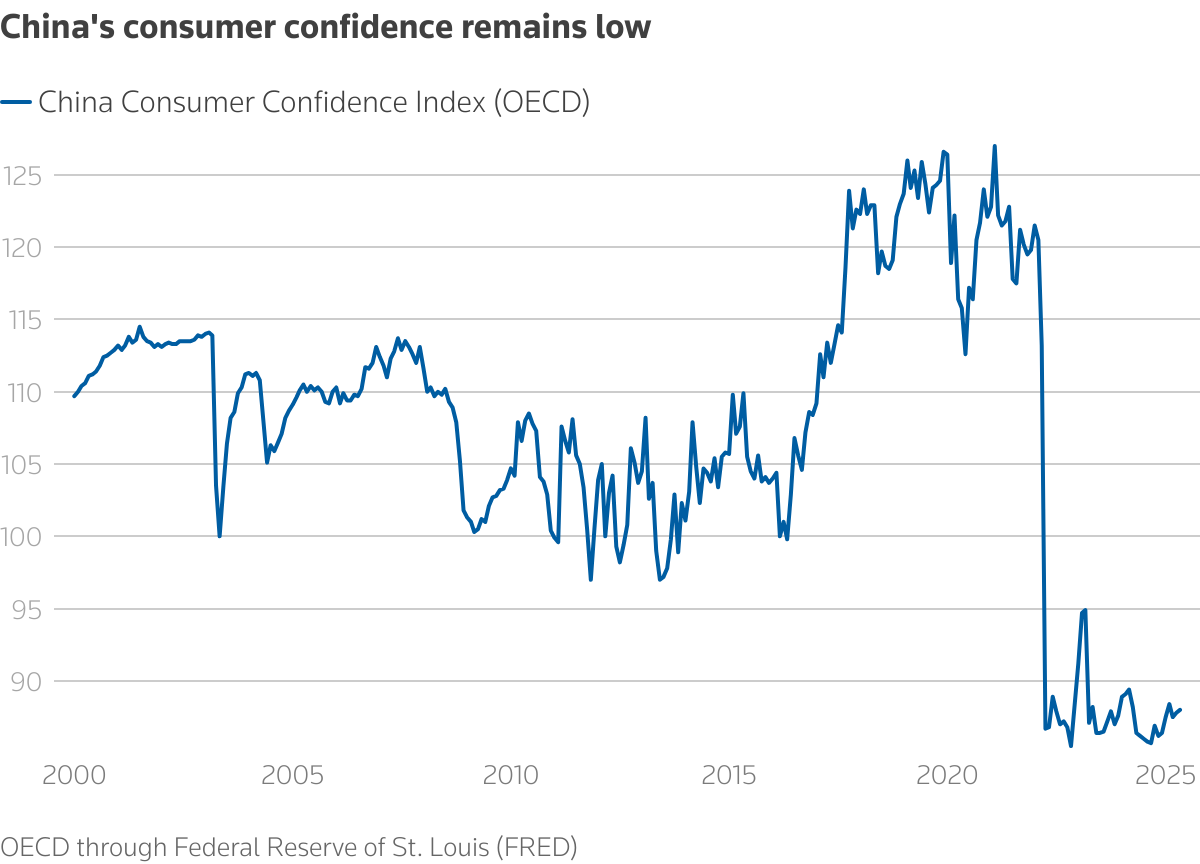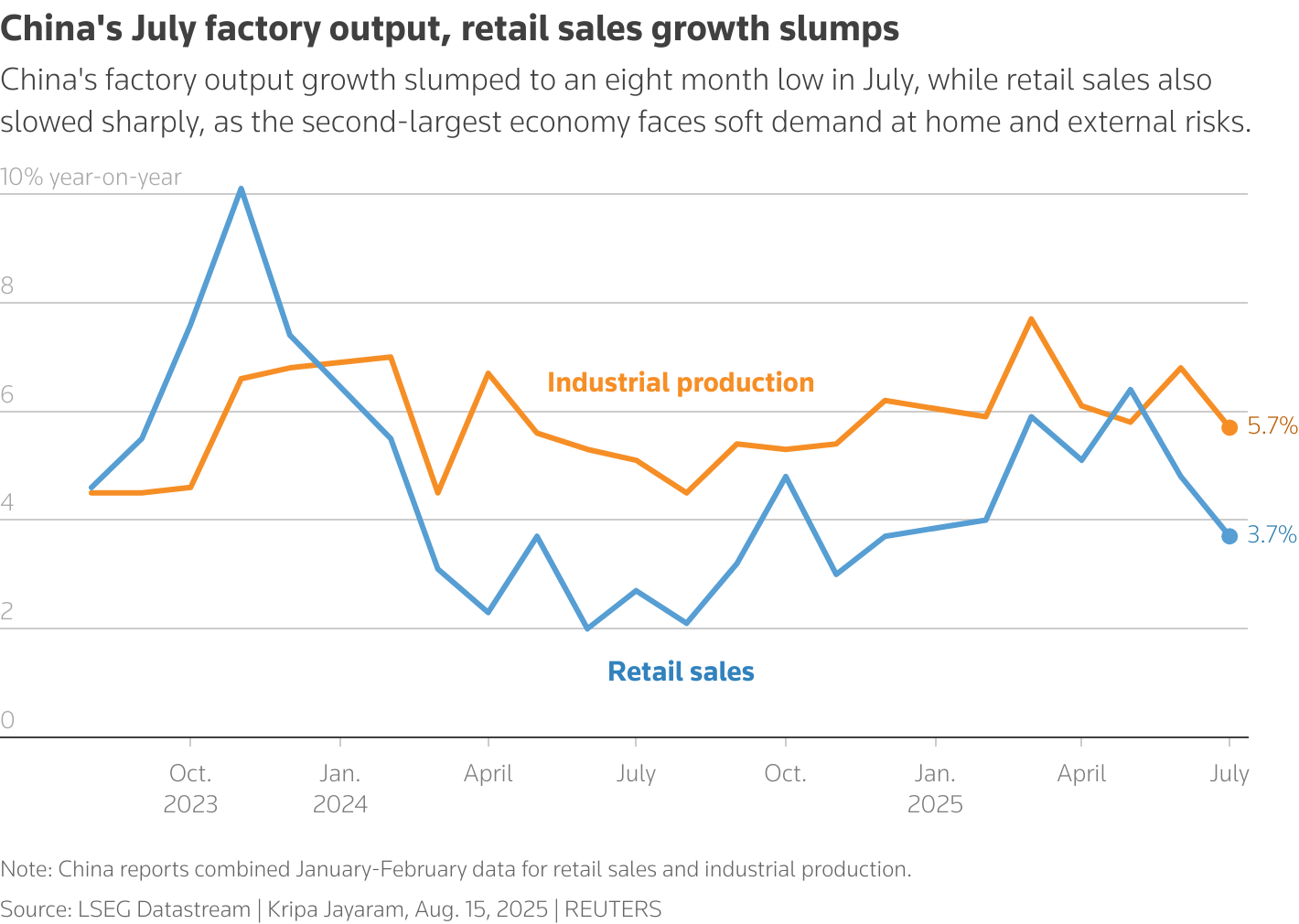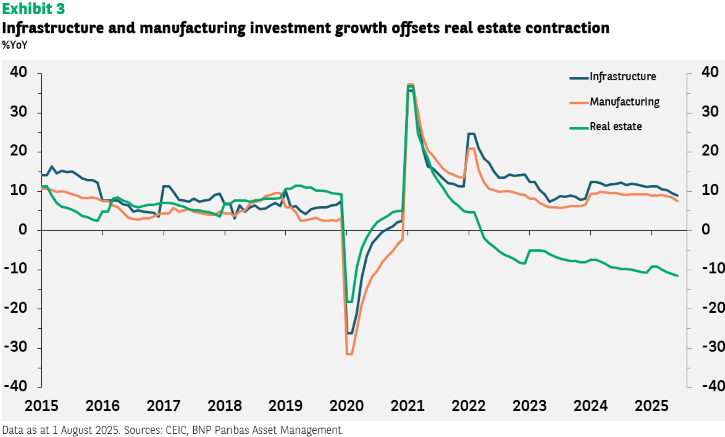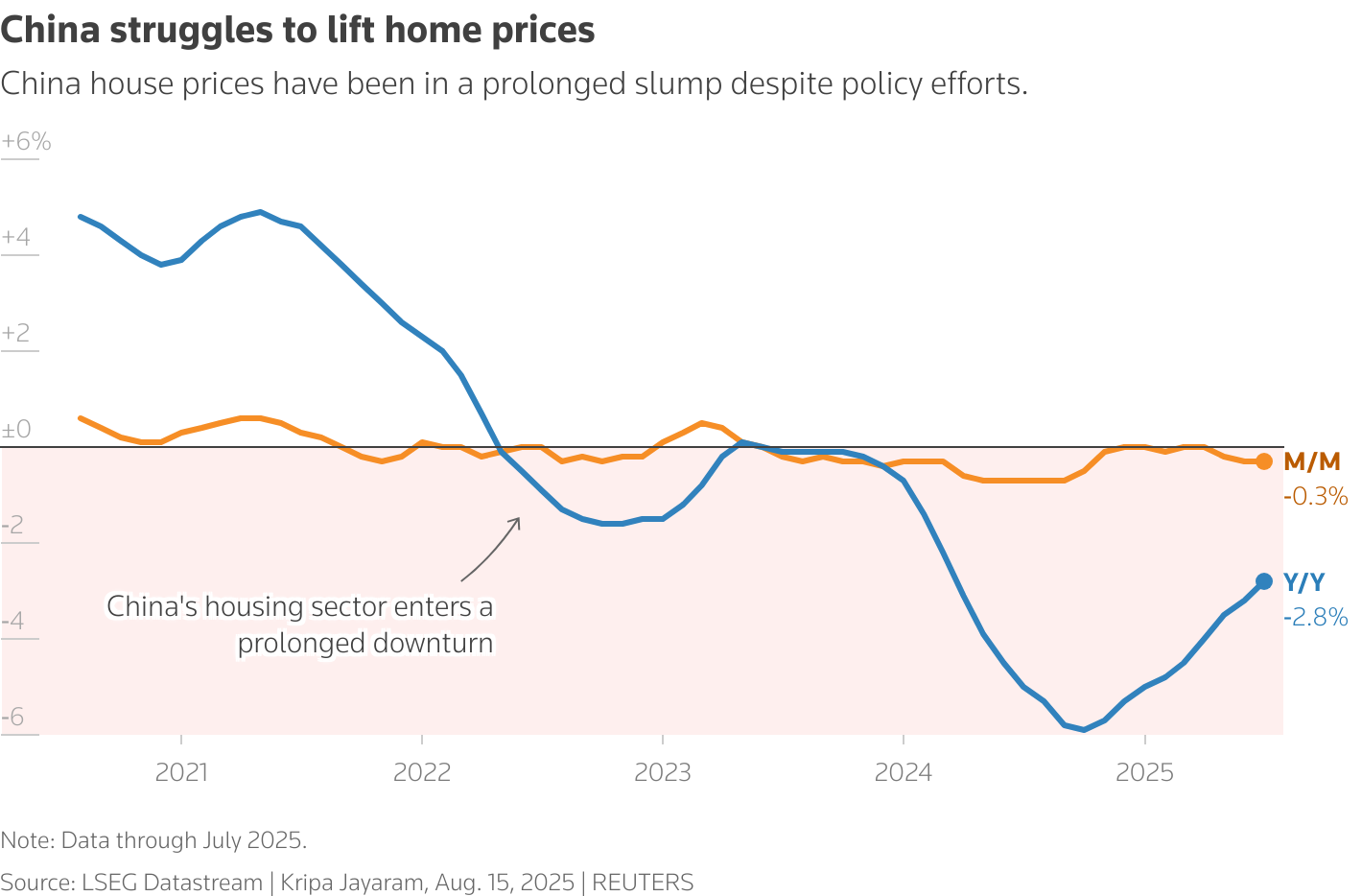CHINA’S SUMMER OF ECONOMIC MISERY:
“April is the cruelest month,” or so begins T. S. Eliot’s bleak modernist masterpiece poem, “The Wasteland.” After seeing China’s July 2025 economic data, Chinese Government officials would certainly beg to differ with Elliot. The numbers in July were dreadful and came on the heels of a string of disappointing monthly data drops, making it arguably the cruelest month yet this year for the Chinese economy. Deflationary pressure persisted, retail sales and industrial output came in below forecasts, with a sharp fall in steel production, urban unemployment edged up, investment activity contracted sharply, and the long-running real estate slump continued.
Starting with the July price data,[1] the producer price index (PPI) dropped 3.6% year-on-year, according to National Bureau of Statistics data. This fall was greater than the 3.3% slide forecasted in a Reuters poll of economists and matched the nearly two-year low recorded in June. The consumer price index was flat year-on-year compared to a 0.1% rise in June. This number was slightly better than the 0.1% decline predicted in a Reuters forecast. Both these numbers indicate that deflation remains a threat to China’s economy.
The July price data points to ongoing weak consumer demand in China’s economy. Retail sales,[2] a key consumption yardstick, went up 3.7% in July, the slowest expansion since December 2024, coming in well below the 4.8% increase in June and missing the 4.6% rise forecasted in a Reuters poll of economists.
Nor is it likely that Chinese consumers will be opening up their wallets anytime soon. Consumer sentiment, as measured by the China Consumer Confidence Index, remained well below its pre-pandemic high[3] all through the first half of 2025.

Industrial output also slowed in July,[4] growing 5.7% year-on-year, down from June’s 6.8% rise, according to the Chinese National Bureau of Statistics. The July increase was the slowest reading since November 2024, falling a bit short of 5.9% rise predicted in a Reuters poll of economists. This slowdown was especially evident in steel,[5] where production fell sharply in July, dropping year-on-year to 79.66 million metric tons, a seven-month low. This decline stemmed from a combination of adverse weather, weakening demand from builders associated with the housing crisis (more on that later), and increased costs of the key inputs of coke and coking coal.
Another indicator of China’s sputtering industrial economy is the private sector S&P Global China Manufacturing PMI,[6] which fell to 49.5 in July, down from 50.4 in June. Any figure below 50 indicates contraction, and the July PMI came in below the expectations of analysts.
The deceleration of industrial output can be seen as a sign that Chinese Government efforts to curb excessive manufacturing output and the cut-throat price competition, or “involution” (内卷化 [Nèi juǎn huà], are starting to bear fruit. Another sign of this is the trend in industrial profits. While these fell 1.5% in July from a year earlier,[7] the third straight monthly decline, reflecting sluggish consumer demand and ongoing PPI deflation, that decrease was not as great as the May and June declines. However, as the retail sales data reviewed earlier shows, the slowdown in consumption growth exceeded that of industrial production. It bears further emphasizing that this has been the case all through 2024 and almost all of the first half of this year.

Of course, China has been closing the gap between its manufacturing output and domestic consumption with exports. Up to now, it has been able to maintain these exports in the face of the rising trade tensions with the US by selling more to other countries. But as the backlash against China’s determination to export away its problem with manufacturing overcapacity grows, this strategy is not going to be sustainable. In fact, according to the S&P Global Survey,[8] new export orders for Chinese goods contracted for a fourth straight month in July, with the pace of that decline exceeding that of June.
To address the “involution” problem, China’s Government therefore needs to focus not just on the supply side of the equation. It also has to boost consumption, especially as it faces growing trade headwinds. Unfortunately, government authorities appear to be backing off efforts to do that during the second half of this year. The consumer trade-in and rebate scheme that led to a spike in household demand for goods earlier this year began being pared back in June,[9] due to funding shortfalls in the face of the huge numbers applying for these handouts.
In 2024, just under 213 million Chinese were employed in manufacturing,[10] or around one-fifth of China’s labor force. With industrial activity and output slowing down, we should expect to see an uptick in unemployment. This is what happened in July, when the urban unemployment rate edged up to 5.2%,[11] slightly exceeding the 5% level in June and May, according to official Chinese Government data. Given the politically sensitive nature of employment data, these figures may well understate the rate of joblessness in China.
Fixed asset investment contracted significantly in July, dropping 5.2% year-on-year, the biggest decline since March 2020, according to estimates from Goldman Sachs. The July plunge dragged down the January-July expansion in fixed asset investment to 1.6%,[12] which was well below analysts’ forecast of a 2.7% growth rate and came in well under the 2.8% rise during the first six months of 2025.
Commenting on these numbers in Reuters,[13] Yuhan Zhang, chief economist at The Conference Board’s China Center, notes, “Firms may be running on existing capacity rather than building new plants.” He adds that the industrial value-added breakdown in the July data “tells a more nuanced story than the fixed asset investment headlines,” further noting that vehicle manufacturing, railways, shipbuilding, aerospace, and other transportation equipment are “outliers (that) indicate policy-driven, high-tech and strategic sectors are still attracting substantial capital.”
As the graph below from BNP Paribus[14] shows, starting at the end of 2021, investment in infrastructure and manufacturing exceeded that in property, helping to offset the sharp contraction in latter. According to Chinese Government data, during the first seven months of 2025, property investment plunged 12%,[15] further widening the gap between investment in that part of China’s economy vs. manufacturing.

The slump in property investment, along with the July data on housing prices, indicate that Chinese real estate remains stuck in the severe downturn that began four years ago. Drawing upon data released by the National Bureau of Statistics, Reuters calculates that new home prices dropped again in July,[16] falling month-on-month by 0.3%. Of the 70 cities the National Bureau of Statistics surveyed, 60 experienced a month-on-month contraction in new home prices, with the decline slowing slightly in first tier cities (these are Beijing, Shanghai, Guangzhou, and Shenzhen). Year-on-Year, new home prices fell 2.8%, nearly matching the 3.2% drop in June. Property sales by floor area were down 4% in July.
The July housing price slump extended to pre-owned homes, even in China’s first tier cities. According to reporting from Bloomberg,[17] the value of these homes fell 0.9% during July. The price of resale homes continued to slide, although the 0.55% fall was not as steep as the 0.61% drop during June.

The one small bit of good housing news in July comes from Fitch Wire,[18] which reports that high-end and luxury projects situated in prime core locations in Tier 1 cites performed robustly. Shanghai stood out as the star performer, with nearly all 25 of these projects going on the market during the first half of 2025 selling out within 24 hours. By contrast, according to Fitch, new apartment complexes and resale homes in non-core locations in Tier 1 cities “generally underperformed.” The situation is far worse in China’s lowest tier cities (Tier 3-5), where “developers have resorted to broader price discounts to drive up sales volumes, intensifying price pressures.” These metropolises saw a massive overbuilding of the housing stock during the 2010-2021 real estate boom,[19] leading to a huge and persisting imbalance between the number of apartments and demand for them.
Save for the lucky duckies buying and owning luxury properties in core areas within Tier 1 cities, there is little relief in sight for beleaguered Chinese homeowners. Fitch predicts that sales of new residential properties by gross floor area will fall by 5% in 2025 and the average selling price of new homes will drop by 2%. This forecast reflects ongoing slumping demand for housing driven by demography, particularly the shrinking cohort of those aged 20-45, the prime age for home purchases, and China’s stumbling economy. Indeed, in the Bloomberg reporting reviewed above, Nomura Securities is warning of a looming “demand cliff” over housing during the rest of 2025.
The ongoing real estate crisis, in turn, is squeezing consumption and contributing to deflationary pressure in China’s economy. As Lynn Song, the chief economist for Greater China for Internationale Nederlanden Greop (ING), declared in a note to clients,[20] “It’s difficult to expect consumers to spend with greater confidence if their biggest asset (he’s referring to home ownership) continues to decline in value every month.”
The recent raft of dismal economic number, culminating in the July data dump, is leading analysts to lower their expectations regarding China’s 2025 GDP growth. The latest Reuters economists poll[21] sees GDP expansion slowing to 4.5% during the third quarter and 4.0% for the fourth quarter of this year. According to this poll, the Chinese 2025 GDP growth rate is now expected to come in at 4.6%, falling short of the Government’s 5% growth target. This downgrade stems from ongoing weakness in household consumption, growing employment insecurity, and possible headwinds created by Trump’s trade war. As Zichun Huang, China Economist at Capital Economics, notes, “We see little reason to expect much of an economic recovery during the rest of this year.”
After 2025 is over, will the official Chinse Government estimate for the year’s GDP growth be less than 5%? Me thinks not, as China’s official annual GDP figure has always matched the government’s growth target—chalk that amazing coincident up to a Chinese economy “special characteristic” (中国的经济的特色 [Zhōngguóde jīngjìde tèsè]).
But regardless of what Beijing says about GDP growth in 2025, as we head well into its second half, it is clearly shaping up to be a subpar year for China’s economy.
[1]. “China’s July Factory-Gate Prices Miss Forecast, Deflation Concerns Persist,” Reuters, August 10, 2025: URL: https://www.reuters.com/world/china/chinas-july-factory-gate-prices-miss-forecast-deflation-concerns-persist-2025-08-09/.
[2]. Kevin Yao, Joe Cash, and Yukun Zhang, “China’s Factory Output, Retail Sales Growth Slump in Blow to Economy,” Reuters, August 15, 2025. URL: https://www.reuters.com/world/china/chinas-factory-output-retail-sales-growth-slump-blow-economy-2025-08-15/.
[3]. Manishi Raychaudhuri, “China’s Fight Against Price Wars is an Uphill Battle,” Reuters, August 12, 2025. URL: https://www.reuters.com/markets/asia/chinas-fight-against-price-wars-is-an-uphill-battle-2025-08-12/#:~:text=The%20government%20has%20responded%20by,began%20offering%20discounts%20and%20subsidies.
[4]. Kevin Yao, Joe Cash, and Yukun Zhang, “China’s Factory Output, Retail Sales Growth Slump in Blow to Economy,” Reuters, August 15, 2025. URL: https://www.reuters.com/world/china/chinas-factory-output-retail-sales-growth-slump-blow-economy-2025-08-15/.
[5]. “China’s July Crude Steel Production hits a Seven-Month Low, Due to Weather Problems,” Offshore Engineering: Energy News, August 15, 2025. URL: https://energynews.oedigital.com/crude-oil/2025/08/15/chinas-july-crude-steel-production-hits-a-sevenmonth-low-due-to-weather-problems#:~:text=shovels%20and%20earthmovers.-,China’s%20July%20crude%20steel%20production%20hits%20a%20seven%2Dmonth%20low,coal%20coking%2C%20two%20key%20inputs.
[6]. “China’s Manufacturing Activity Shrinks as Exports drag, S&P PMI Shows,” Reuters, July 31, 2025. URL: https://www.reuters.com/world/china/chinas-manufacturing-activity-shrinks-exports-drag-sp-pmi-shows-2025-08-01/.
[7]. “China’s Crackdown on Price Wars Eases Industrial Profits Drop,” Bloomberg, August 26, 2025. URL: https://www.bloomberg.com/news/articles/2025-08-27/china-s-industrial-profits-extend-drop-to-third-straight-month.
[8]. “China’s Manufacturing Activity Shrinks as Exports drag, S&P PMI Shows,” Reuters, July 31, 2025. URL: https://www.reuters.com/world/china/chinas-manufacturing-activity-shrinks-exports-drag-sp-pmi-shows-2025-08-01/.
[9]. “China Consumer Rush for Subsidies Overloads Stimulus Program,” Bloomberg, June 17, 2025. URL: https://www.bloomberg.com/news/articles/2025-06-17/china-s-consumer-rush-for-subsidies-overloads-stimulus-program.
[10]. “Breakdown of the Workforce across Economic Sectors in China from 2014 to 2024 (in Millions),” Statista, No Date. URL: https://www.statista.com/statistics/278346/economic-sector-distribution-of-the-workforce-in-china/.
[11]. Anniek Bao, “China’s Growth Stumbles in July, as Retail Sales, Industrial Output Miss Forecasts,” CNBC, August 14, 2025. URL: https://www.cnbc.com/2025/08/15/chinas-growth-stumbles-in-july-as-weak-demand-industrial-capacity-curbs-weigh.html.
[12]. Anniek Bao, “China’s Growth Stumbles in July, as Retail Sales, Industrial Output Miss Forecasts,” CNBC, August 14, 2025. URL: https://www.cnbc.com/2025/08/15/chinas-growth-stumbles-in-july-as-weak-demand-industrial-capacity-curbs-weigh.html.
[13]. Kevin Yao, Joe Cash, and Yukun Zhang, “China’s Factory Output, Retail Sales Growth Slump in Blow to Economy,” Reuters, August 15, 2025. URL: https://www.reuters.com/world/china/chinas-factory-output-retail-sales-growth-slump-blow-economy-2025-08-15/.
[14]. Chi Lo, “Viewpoint: China—Involution, Deflation and Structural Reform,” BNP Paribus, August, 11, 2025. URL: https://viewpoint.bnpparibas-am.com/china-involution-deflation-and-structural-reform/#:~:text=It%20refers%20to%20excessive%20and,1990s%20(see%20Exhibit%201).
[15]. Anniek Bao, “China’s Growth Stumbles in July, as Retail Sales, Industrial Output Miss Forecasts,” CNBC, August 14, 2025. URL: https://www.cnbc.com/2025/08/15/chinas-growth-stumbles-in-july-as-weak-demand-industrial-capacity-curbs-weigh.html.
[16]. “China’s New Home Prices Fall Again but Declines Ease in Major Cities,” Reuters, August 14, 2025. URL: https://www.reuters.com/world/china/chinas-new-home-prices-fall-again-declines-ease-major-cities-2025-08-15/#:~:text=China’s%20new%20home%20prices%20fall%20again%20but%20declines%20ease%20in%20major%20cities,-By%20Reuters&text=BEIJING%2C%20Aug%2015%20(Reuters),further%20support%20is%20still%20needed.
[17]. “China New-Home Prices Drop as Stimulus Fails to Halt Slide,” Bloomberg, August 14, 2025. URL: https://www.bloomberg.com/news/articles/2025-08-15/china-new-home-prices-drop-as-stimulus-fails-to-halt-slide.
[18]. “China Property Market’s Polarised Performance Leaves Risks Elevated,” Fitch Wire, August 5, 2025. URL: https://www.fitchratings.com/research/corporate-finance/china-property-markets-polarised-performance-leaves-risks-elevated-05-08-2025.
[19]. Kenneth Rogoff and Yang Yuanchen, “A Tale of Tier 3 Cities,” IMF Working Paper WP/22/196, September 2022. URL: https://www.imf.org/en/Publications/WP/Issues/2022/09/29/A-Tale-of-Tier-3-Cities-524064.
[20]. Kevin Yao, Joe Cash, and Yukun Zhang, “China’s Factory Output, Retail Sales Growth Slump in Blow to Economy,” Reuters, August 15, 2025. URL: https://www.reuters.com/world/china/chinas-factory-output-retail-sales-growth-slump-blow-economy-2025-08-15/.
[21]. Kevin Yao, Joe Cash, and Yukun Zhang, “China’s Factory Output, Retail Sales Growth Slump in Blow to Economy,” Reuters, August 15, 2025. URL: https://www.reuters.com/world/china/chinas-factory-output-retail-sales-growth-slump-blow-economy-2025-08-15/.
